United States Air Service
USAS HistorySummary 1917-1918 Lafayette Escadrille
N.124/Spa.124 1st Observation
1st, 12th, 50th, 88th 1st Pursuit Group
27th, 94th, 95th, 147th 1st Bombardment
96th, 11th, 20th 2nd Pursuit Group
13th, 22nd, 49th, 139th 3rd Pursuit Group
28th, 93rd, 103rd, 213th 4th Pursuit Group
17th, 148th, 25th, 141st 5th Pursuit Group
41st, 138th, 638th 3rd Air Park
255th. List of Aces
United States Naval Aviation
US Naval AviationUnited States Marine Corps Aviation
US Marine AviationAircraft
 Nieuport 28
Spad VII
Spad XIII
Fokker Dr.1
Albatros D.Va
Fokker D.VII
Nieuport 28
Spad VII
Spad XIII
Fokker Dr.1
Albatros D.Va
Fokker D.VII
Website: Atlanta SEO
E-mail us
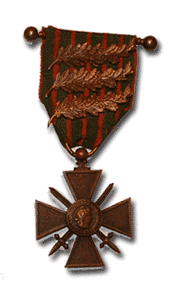
Raoul Lufbery
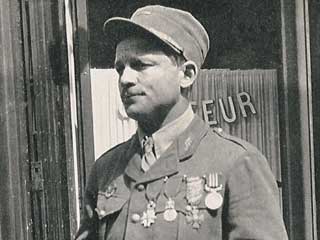
On May 24, 1916, quiet Raoul Lufbery, 31, became the first new member to join the Lafayette Escadrille. Short, stocky and prosaic in looks, Lufbery would soon emerge as the top ace and most famous of the members of the Lafayette Escadrille.
Lufbery was born in central France, near Clermont-Ferrand on March 21, 1885 of a French mother and an American father of French origin named Edouard Lufbery. Despite his French birth and broken English, he considered himself American and had naturalized a few years earlier.
He traveled around the world and eventually met a French stunt-pilot named Marc Pourpe in Calcutta, India in 1912. Lufbery signed on as Pourpe's mechanic and the two became fast and dear friends. Somewhere along the line Pourpe taught Lufbery to fly.
As a naturalized American, Lufbery had to join the French Foreign Legion, but Pourpe managed to get Lufbery assigned as his mechanic. On December 2, 1914, Pourpe was killed in a crash, devastating Lufbery. He bitterly swore to avenge his friend's death which is what led him to the Lafayette Escadrille.
Raoul Lufbery. Photo courtesy www.overthefront.com.
Lufbery got his first victory on July 31st then got two more over Verdun's Fort Vaux on August 8th. He ended that day with a hat trick giving him four victories in total. On the 16th, Lufbery received the Croix de Guerre and Medaille Militaire. It was an auspicious start for the new, determined pilot.
December 27, 1916 was the first good flying day in a long time. Lufbery made the best of it tallying another victory. On January 24, 1917 Lufbery added yet another victim to his score.
Off the ground, Lufbery was going from success to success, flying three or four missions a day and racking up a disproportionate number of the Escadrille's victories. In doing so, he became the natural instructor of the group, going to great lengths to teach his techniques to new members and veterans alike. And, as the undisputed star of the group, Lufbery was bombarded by perfume laced letters from adoring females.
On December 2, 1917, Lufbery scored two more victories. Other than that, the winter months were quiet. The fliers led a binary existence: flying or relaxing with little in between.
There was nothing which foresaw a tragic ending the morning of May 19, 1918. Lufbery took off in another pilot's Nieuport 28 in an effort to aid a pilot being bested by a German observation plane. Lufbery climbed rapidly, closed, fired at the German plane and then backed off in order to clear a jammed gun. The German observer turned the tables on him and then hit Lufbery's Nieuport as they flew over the village of Maron seven miles southeast of the Toul aerodrome.
The critical hit was inflicted by a bullet that entered his reserve fuel tank setting it on fire then continuing clear through it slicing off part of Lufbery's right thumb. There are two different versions of what happened next. In one version, the entire front end of the plane quickly caught on fire. Lufbery had always told his protégés like Ricken-backer to stay in a burning plane rather than jump. "I've never seen a guy jump out of one on fire and live, but I know of four or five that have ridden them into the ground and lived." The flames might go out by themselves he also explained to them. At first Lufbery tried just that, side-slipped the plane on its way down, hoping either to keep the flames at bay or to extinguish them. Instead of going out, the flames got hellishly worse. Finally, still about two thousand feet off of the ground, Lufbery was seen jumping out of the plane aiming himself at the Moselle River hoping to hit it to save his life. In the other version, when the bullet sliced through his thumb, he lost control of the plane. In his haste to take off, he had not properly secured his seat belt. After losing control, he fell out of the plane. In either case, he landed lengthwise on a picket fence surrounding the flower garden of a peasant woman's yard near the village of Maron. Rickenbacker and others arrived within 30 minutes to find that the villagers had already taken Lufbery's body to the town square and covered it with flowers from nearby gardens.
Lufbery's coffin was brought back to the barracks at Toul. The next day the American ace of aces was buried, surrounded in tribute by hundreds of officers including Eddie Rickenbacker, Billy Mitchell, General Gerard, commander of the French VIth Army, and General Ligett, commander of the 26th Division. Rickenbacker went back to the Aerodrome shortly after, took off with a flight of pilots who flew over the gravesite and dropped flowers in their wake. The Germans flew over and dropped flowers as well.
Ironically, the pilot whose Nieuport Lufbery had borrowed met his own end in Lufbery's Nieuport several weeks later.
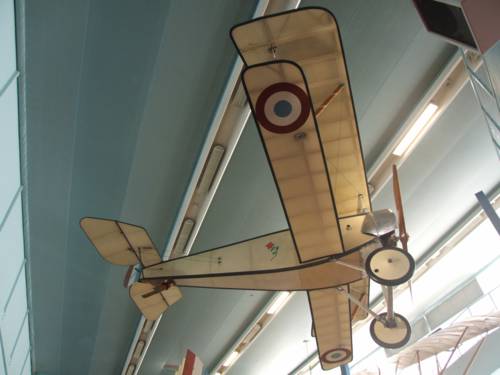
Nieuport 11 which along with the Nieuport 17 and the Spad VII was the type used by Lufbery and Lafayette Escadrille
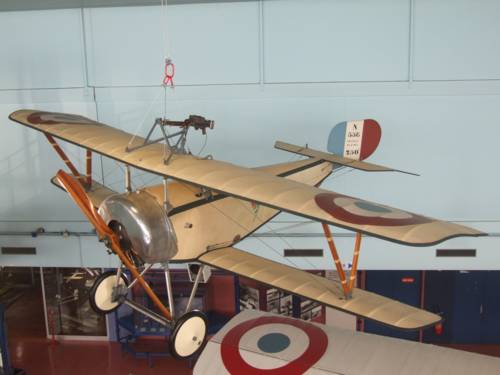
Nieuport 11 which along with the Nieuport 17 and the Spad VII was the type used by Lufbery and Lafayette Escadrille
A special thanks to Bob Stickle and Diana Lufbery Stickle for this update to Raoul Lufbery's medals:
Croix de Guerre, 10 palms - essentially the equivalent of 10 Croix de Guerres.
British Military Medal
Purple Heart (posthumous)
WWI Victory Medal
Connecticut Veterans Wartime Service Medal
Numerous citations from the French Army
Medal from Montenegro
Legion d'Honneur de Chevalier
Medaille d'Or
Bob also adds:
"A part of I-91 in Ct was named after the Major in Oct of 2011. In 1954, Lufbery Avenue in Wallingford, CT was named for him. Eddie Rickenbacker was the main speaker at that event. He has also been enshrined in The United States National Aviation Hall of Fame."
Update: Sat. May 5, 2018 11:00 AM - 12:00 PM EDT, Wallingford, CT will honor Raoul Lufbery near the centennial of his death. A plaque will be unveiled, etc., in a formal ceremony at the Wallingford Historical Society. There will also be a parade and post ceremony reception.
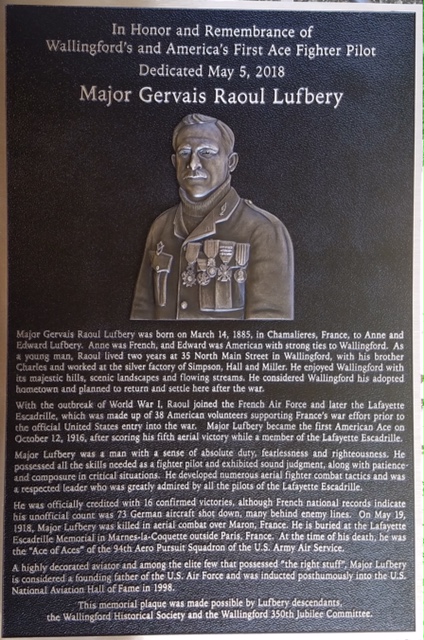
Raoul Lufbery plaque; photo Robert Stickle.
Related Links: Quentin Roosevelt | Frank Luke | Eddie Rickenbacker | Raoul Lufbery | Eugene Bullard | David Ingalls - 1st Navy Ace | "American Eagles" - 345 page illustrated history of US Combat Aviation in World War I
Events/Airshows
 Events/Airshows
Events/Airshows
Pilots/Aviators
 Raoul Lufbery
Raoul LufberyAce of Aces Eddie Rickenbacker
26 victories Quentin Roosevelt
Son of President KIA Frank Luke
18 victories in 17 days Eugene Bullard
1st African Am. Pilot David Ingalls
1st US Navy Ace List of USAS Pilots
Find a Relative American WWI Pilots
Mini bios
USAS Research
 USAS Videos
Reading List
USAS Videos
Reading ListWWI US Aviation Related Links
WWI US Aviation Credits War Wings
by Phillip W. Stewart WWI Maps
Units & Airfields Payne Field
USAS Aerodromes now... USAS Archives
Questions? Need Help? American Expeditionary Forces
WWI Doughboys in France